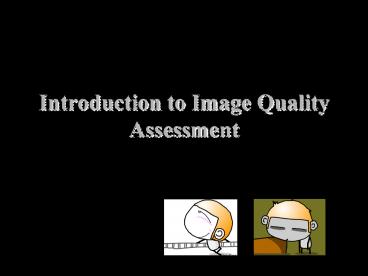Introduction to Image Quality Assessment - PowerPoint PPT Presentation
1 / 33
Title: Introduction to Image Quality Assessment
1
Introduction to Image Quality Assessment
2
Outline
- Applications
- Image Quality Assessment
- Image Quality Assessment with Reference Image
- -Zhou Wang and Alan C. Bovik, ICASSP2002
- Blind Image Quality Assessment
- -Xin Li, ICIP2002
3
Image Quality ?
4
Image Quality Assessment
Good
Bad
5
Applications
- Image Acquisition Systems and Display Systems
- Image Processing Systems and Algorithms
- Compression and Network
6
Image Quality Assessment
- Mean Opinion Score
- Automatically Image Quality Evaluation
7
Mean-Squared Error and Peak Signal-to-Noise Ratio
8
Frequency-domain SNR
9
Frequency-domain SNR
10
Image Quality Assessment Methods
- Image Quality Assessment with Reference Image
- Blind Image Quality Assessment
11
Image Quality Assessment Methods
- Image Quality Assessment with Reference Image
- Blind Image Quality Assessment
12
Error Sensitivity Based Image Quality Measurement
13
Error Sensitivity Based Image Quality Measurement
alignment, luminance transformation, and color
transformation
14
Error Sensitivity Based Image Quality Measurement
resulting in two sets of transformed signals for
different channels
15
Error Sensitivity Based Image Quality Measurement
The errors between the two signals in each
channel are calculated and weighted, usually by a
Contrast Sensitivity Function (CSF).
16
Error Sensitivity Based Image Quality Measurement
The weighted error signals are adjusted by a
visual masking effect model, which reflects the
reduced visibility of errors presented on the
background signal
17
Visual Masking Effect
18
Error Sensitivity Based Image Quality Measurement
Minkowski error pooling
19
Weaknesses of Error Sensitivity Based Methods
- The reference signal is of perfect quality
- There exist visual channels in the HVS and the
channel responses can be simulated by an
appropriate set of channel transformations. - CSF variance and intra-channel masking effects
are the dominant factors that affect the HVSs
perception on each transformed coefficient in
each channel
OK!
20
Weaknesses of Error Sensitivity Based Methods
- For a single coefficient in each channel, after
CSF weighting and masking, the relationship
between the magnitude of the error and the
distortion perceived by the HVS can be modeled as
a non-linear function. - The interaction between channels is small enough
to be ignored.
21
Weaknesses of Error Sensitivity Based Methods
- The perceived image quality is determined in the
early vision system. Higher level processes, such
as feature extraction, pattern matching and
cognitive understanding happening in the human
brain, are less effective - Active visual processes, such as the change of
fixation points and the adaptive adjustment of
spatial resolution because of attention, are less
effective
22
Structure Distortion Based ImageQuality
Measurement
- The main function of the human eyes is to extract
structural information from the viewing field,
and the human visual system is highly adapted for
this purpose. Therefore, a measurement of
structural distortion should be a good
approximation of perceived image distortion
23
Structure Distortion Based ImageQuality
Measurement
24
Structure Distortion Based ImageQuality
Measurement
loss of correlation, mean distortion, and
variance distortion
25
Experimental Results
a original b 0.9372 c 0.3891 d 0.6494 e
0.3461 f 0.2876
26
Image Quality Assessment Methods
- Image Quality Assessment with Reference Image
- Blind Image Quality Assessment
27
Blind Image Quality Assessment
- Human visual system usually does not need any
reference to determine the subjective quality of
a target image - Distinction between fidelity and quality
28
Blind Image Quality Assessment
- Edge Sharpness Level
- Random Noise Level
- Structured Noise Level
29
Edge Sharpness Level
30
Random Noise Level
- Impulse Noise
- Additive White Gaussian Noise
31
Structured Noise Level
- Block Artifact
- Ringing Artifact
32
Blind Image Quality Assessment
- Combination of different measurement is still a
problem.
33
Conclusion
- Image Quality Assessment with Reference Image
- Blind Image Quality Assessment































